Aerodynamic Factors in Air France Airbus A330 Flight AF447 Accident
VerifiedAdded on 2022/10/19
|13
|2468
|31
Case Study
AI Summary
This case study investigates the Air France Airbus A330 Flight AF447 accident from an aerodynamic perspective. It analyzes the roles of thrust, drag, and weight, and how these factors contributed to the crash. The study examines the effects of the aerodynamic load factor, icing, and stall conditions. The methodology includes primary data collection through interviews and secondary data from air traffic control transcripts. The study highlights the importance of understanding aerodynamic principles, particularly the relationship between lift, drag, and thrust, and their impact on aircraft stability and control. The analysis identifies the chain of events leading to the accident, emphasizing the significance of pilot responses and the limitations of existing safety measures. The case study includes a summary, introduction, methodology, findings, conclusion, and recommendations for flight safety improvements, with all sources acknowledged in APA style.
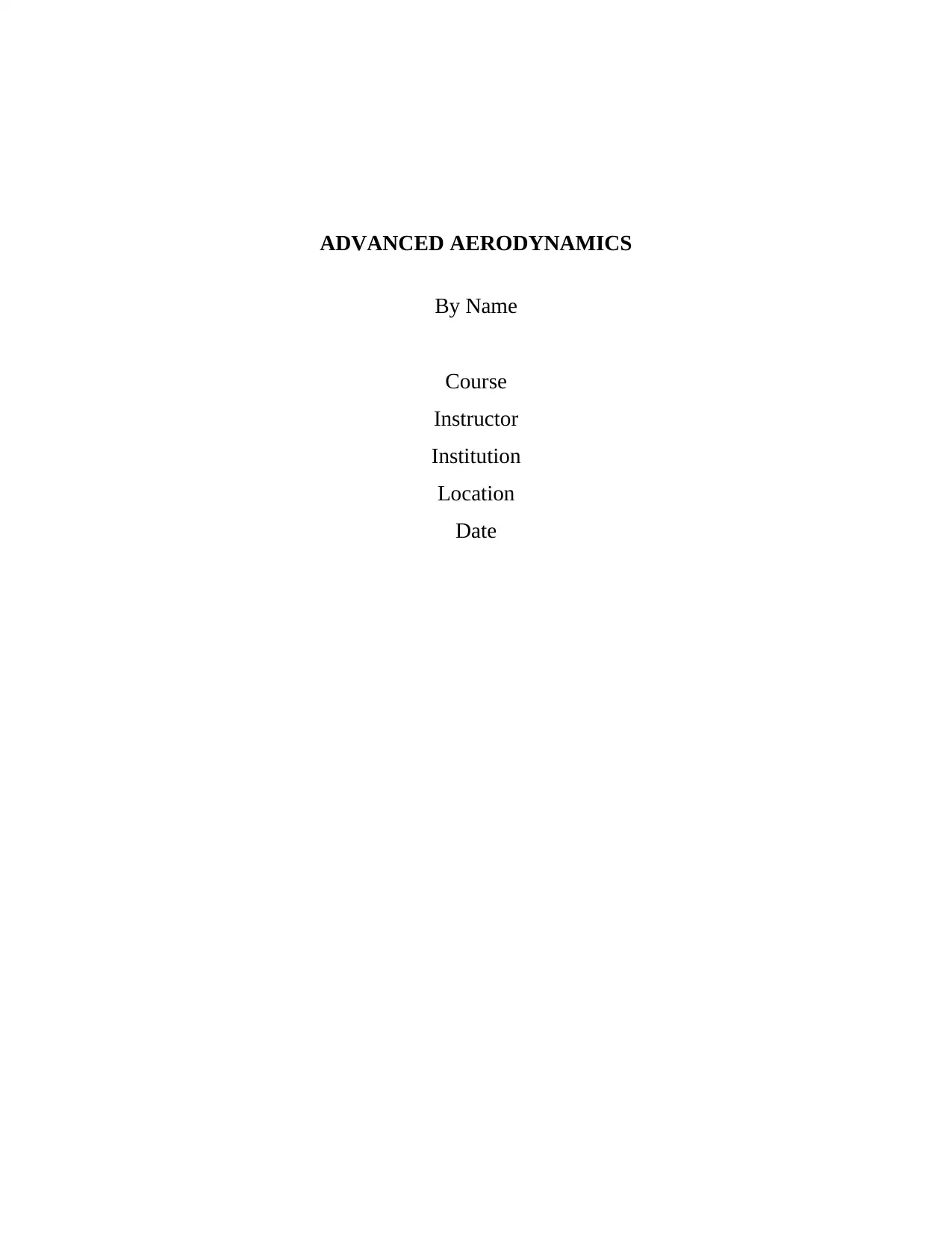
ADVANCED AERODYNAMICS
By Name
Course
Instructor
Institution
Location
Date
By Name
Course
Instructor
Institution
Location
Date
Paraphrase This Document
Need a fresh take? Get an instant paraphrase of this document with our AI Paraphraser
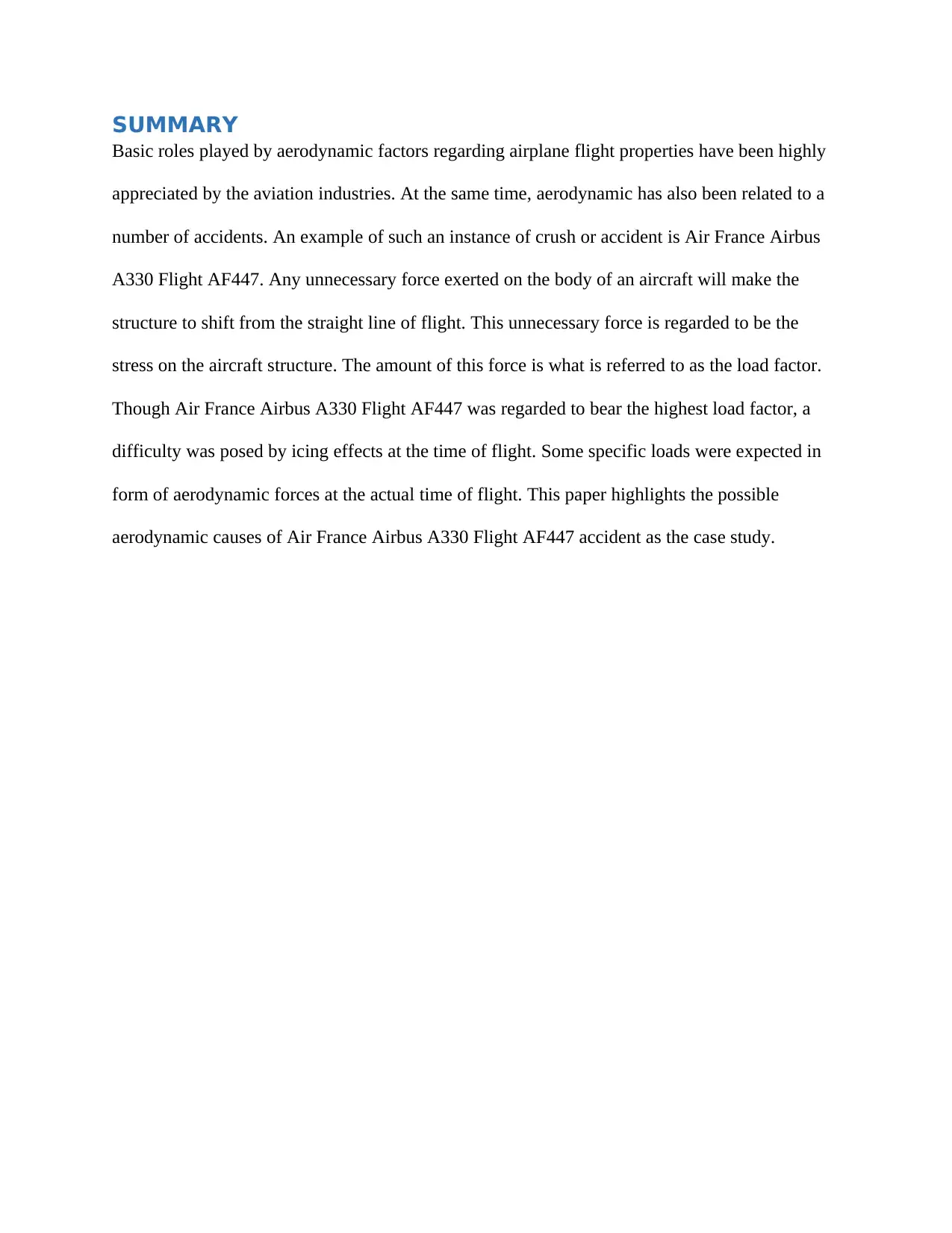
SUMMARY
Basic roles played by aerodynamic factors regarding airplane flight properties have been highly
appreciated by the aviation industries. At the same time, aerodynamic has also been related to a
number of accidents. An example of such an instance of crush or accident is Air France Airbus
A330 Flight AF447. Any unnecessary force exerted on the body of an aircraft will make the
structure to shift from the straight line of flight. This unnecessary force is regarded to be the
stress on the aircraft structure. The amount of this force is what is referred to as the load factor.
Though Air France Airbus A330 Flight AF447 was regarded to bear the highest load factor, a
difficulty was posed by icing effects at the time of flight. Some specific loads were expected in
form of aerodynamic forces at the actual time of flight. This paper highlights the possible
aerodynamic causes of Air France Airbus A330 Flight AF447 accident as the case study.
Basic roles played by aerodynamic factors regarding airplane flight properties have been highly
appreciated by the aviation industries. At the same time, aerodynamic has also been related to a
number of accidents. An example of such an instance of crush or accident is Air France Airbus
A330 Flight AF447. Any unnecessary force exerted on the body of an aircraft will make the
structure to shift from the straight line of flight. This unnecessary force is regarded to be the
stress on the aircraft structure. The amount of this force is what is referred to as the load factor.
Though Air France Airbus A330 Flight AF447 was regarded to bear the highest load factor, a
difficulty was posed by icing effects at the time of flight. Some specific loads were expected in
form of aerodynamic forces at the actual time of flight. This paper highlights the possible
aerodynamic causes of Air France Airbus A330 Flight AF447 accident as the case study.
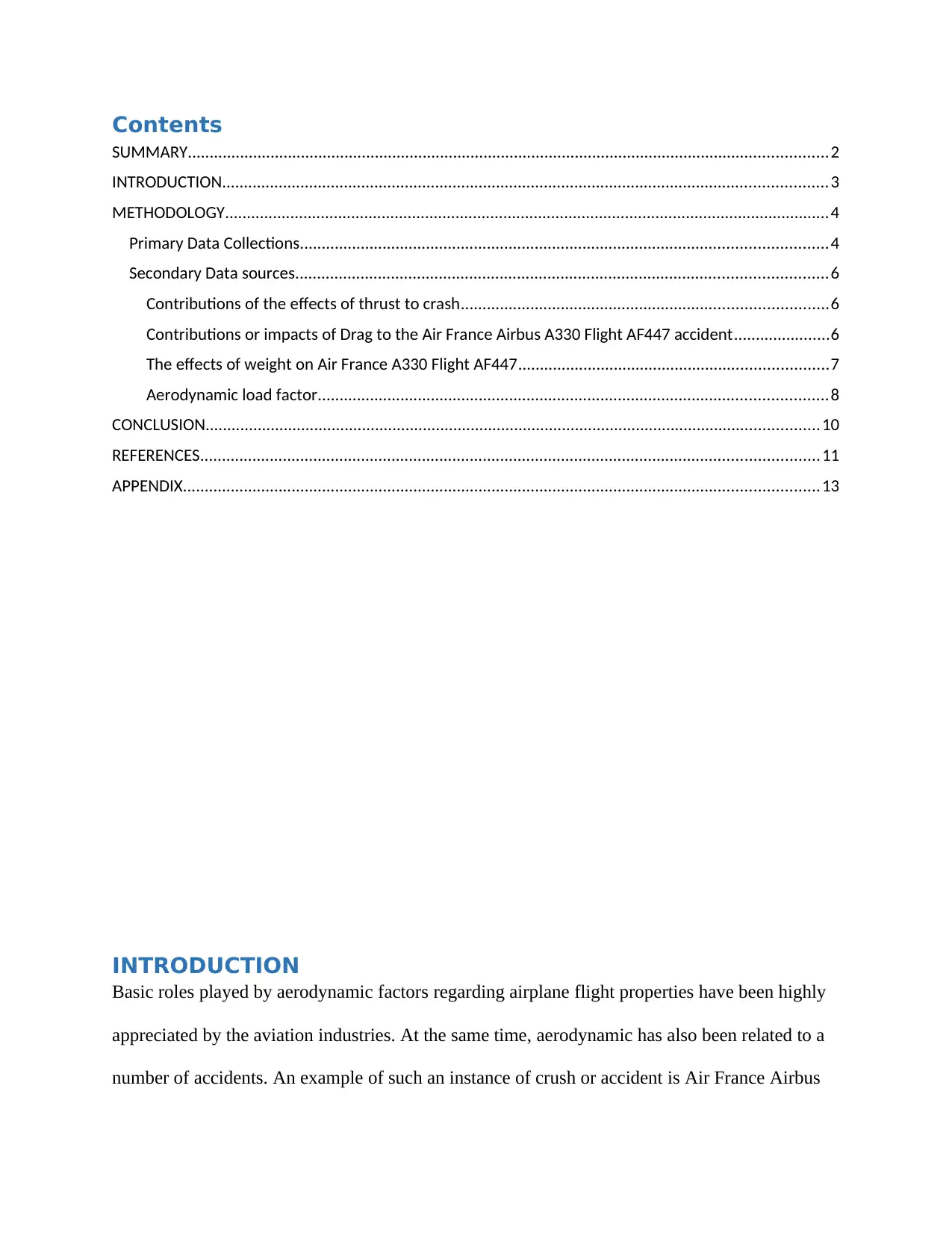
Contents
SUMMARY...................................................................................................................................................2
INTRODUCTION...........................................................................................................................................3
METHODOLOGY...........................................................................................................................................4
Primary Data Collections.........................................................................................................................4
Secondary Data sources..........................................................................................................................6
Contributions of the effects of thrust to crash....................................................................................6
Contributions or impacts of Drag to the Air France Airbus A330 Flight AF447 accident......................6
The effects of weight on Air France A330 Flight AF447.......................................................................7
Aerodynamic load factor.....................................................................................................................8
CONCLUSION.............................................................................................................................................10
REFERENCES..............................................................................................................................................11
APPENDIX..................................................................................................................................................13
INTRODUCTION
Basic roles played by aerodynamic factors regarding airplane flight properties have been highly
appreciated by the aviation industries. At the same time, aerodynamic has also been related to a
number of accidents. An example of such an instance of crush or accident is Air France Airbus
SUMMARY...................................................................................................................................................2
INTRODUCTION...........................................................................................................................................3
METHODOLOGY...........................................................................................................................................4
Primary Data Collections.........................................................................................................................4
Secondary Data sources..........................................................................................................................6
Contributions of the effects of thrust to crash....................................................................................6
Contributions or impacts of Drag to the Air France Airbus A330 Flight AF447 accident......................6
The effects of weight on Air France A330 Flight AF447.......................................................................7
Aerodynamic load factor.....................................................................................................................8
CONCLUSION.............................................................................................................................................10
REFERENCES..............................................................................................................................................11
APPENDIX..................................................................................................................................................13
INTRODUCTION
Basic roles played by aerodynamic factors regarding airplane flight properties have been highly
appreciated by the aviation industries. At the same time, aerodynamic has also been related to a
number of accidents. An example of such an instance of crush or accident is Air France Airbus
⊘ This is a preview!⊘
Do you want full access?
Subscribe today to unlock all pages.

Trusted by 1+ million students worldwide
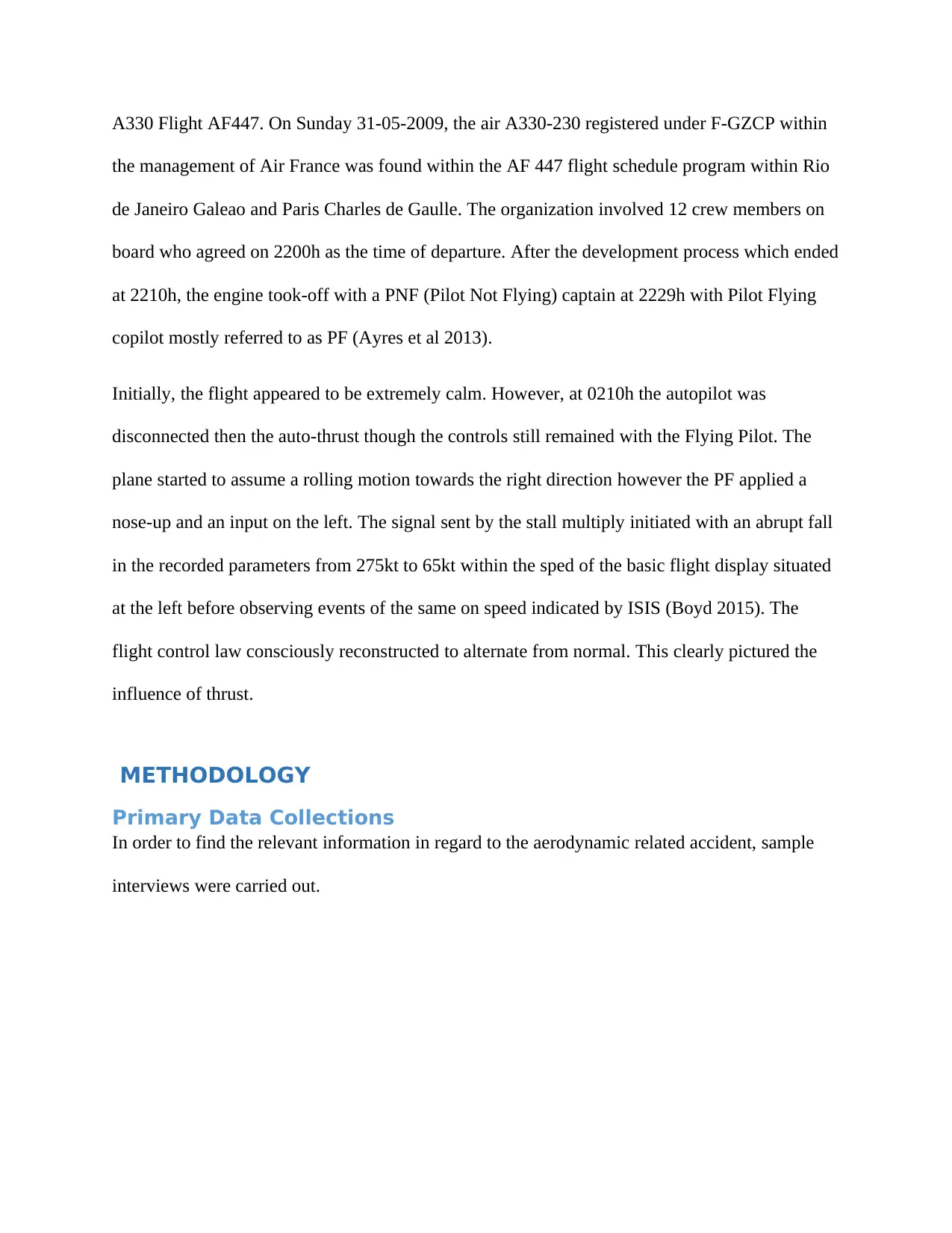
A330 Flight AF447. On Sunday 31-05-2009, the air A330-230 registered under F-GZCP within
the management of Air France was found within the AF 447 flight schedule program within Rio
de Janeiro Galeao and Paris Charles de Gaulle. The organization involved 12 crew members on
board who agreed on 2200h as the time of departure. After the development process which ended
at 2210h, the engine took-off with a PNF (Pilot Not Flying) captain at 2229h with Pilot Flying
copilot mostly referred to as PF (Ayres et al 2013).
Initially, the flight appeared to be extremely calm. However, at 0210h the autopilot was
disconnected then the auto-thrust though the controls still remained with the Flying Pilot. The
plane started to assume a rolling motion towards the right direction however the PF applied a
nose-up and an input on the left. The signal sent by the stall multiply initiated with an abrupt fall
in the recorded parameters from 275kt to 65kt within the sped of the basic flight display situated
at the left before observing events of the same on speed indicated by ISIS (Boyd 2015). The
flight control law consciously reconstructed to alternate from normal. This clearly pictured the
influence of thrust.
METHODOLOGY
Primary Data Collections
In order to find the relevant information in regard to the aerodynamic related accident, sample
interviews were carried out.
the management of Air France was found within the AF 447 flight schedule program within Rio
de Janeiro Galeao and Paris Charles de Gaulle. The organization involved 12 crew members on
board who agreed on 2200h as the time of departure. After the development process which ended
at 2210h, the engine took-off with a PNF (Pilot Not Flying) captain at 2229h with Pilot Flying
copilot mostly referred to as PF (Ayres et al 2013).
Initially, the flight appeared to be extremely calm. However, at 0210h the autopilot was
disconnected then the auto-thrust though the controls still remained with the Flying Pilot. The
plane started to assume a rolling motion towards the right direction however the PF applied a
nose-up and an input on the left. The signal sent by the stall multiply initiated with an abrupt fall
in the recorded parameters from 275kt to 65kt within the sped of the basic flight display situated
at the left before observing events of the same on speed indicated by ISIS (Boyd 2015). The
flight control law consciously reconstructed to alternate from normal. This clearly pictured the
influence of thrust.
METHODOLOGY
Primary Data Collections
In order to find the relevant information in regard to the aerodynamic related accident, sample
interviews were carried out.
Paraphrase This Document
Need a fresh take? Get an instant paraphrase of this document with our AI Paraphraser
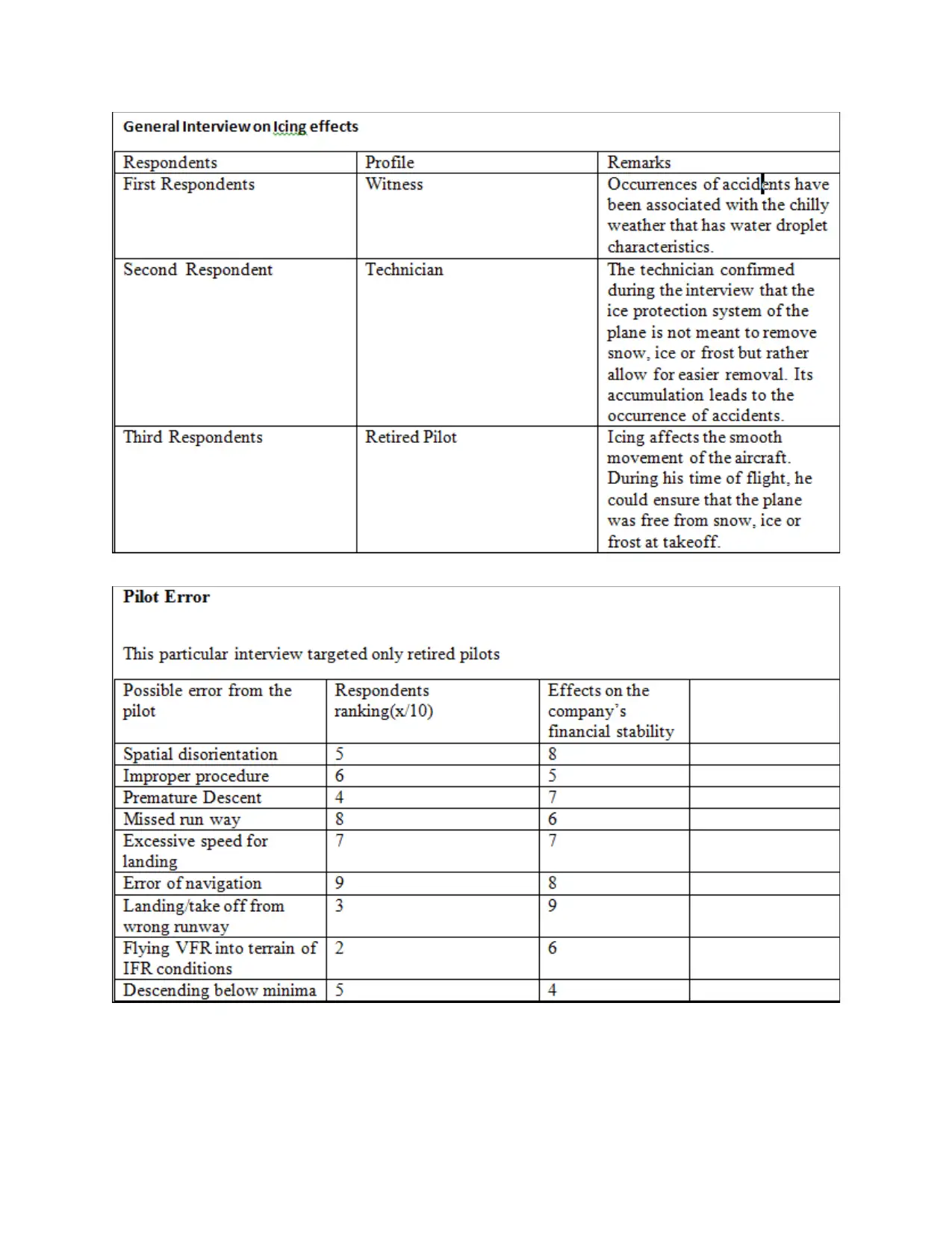
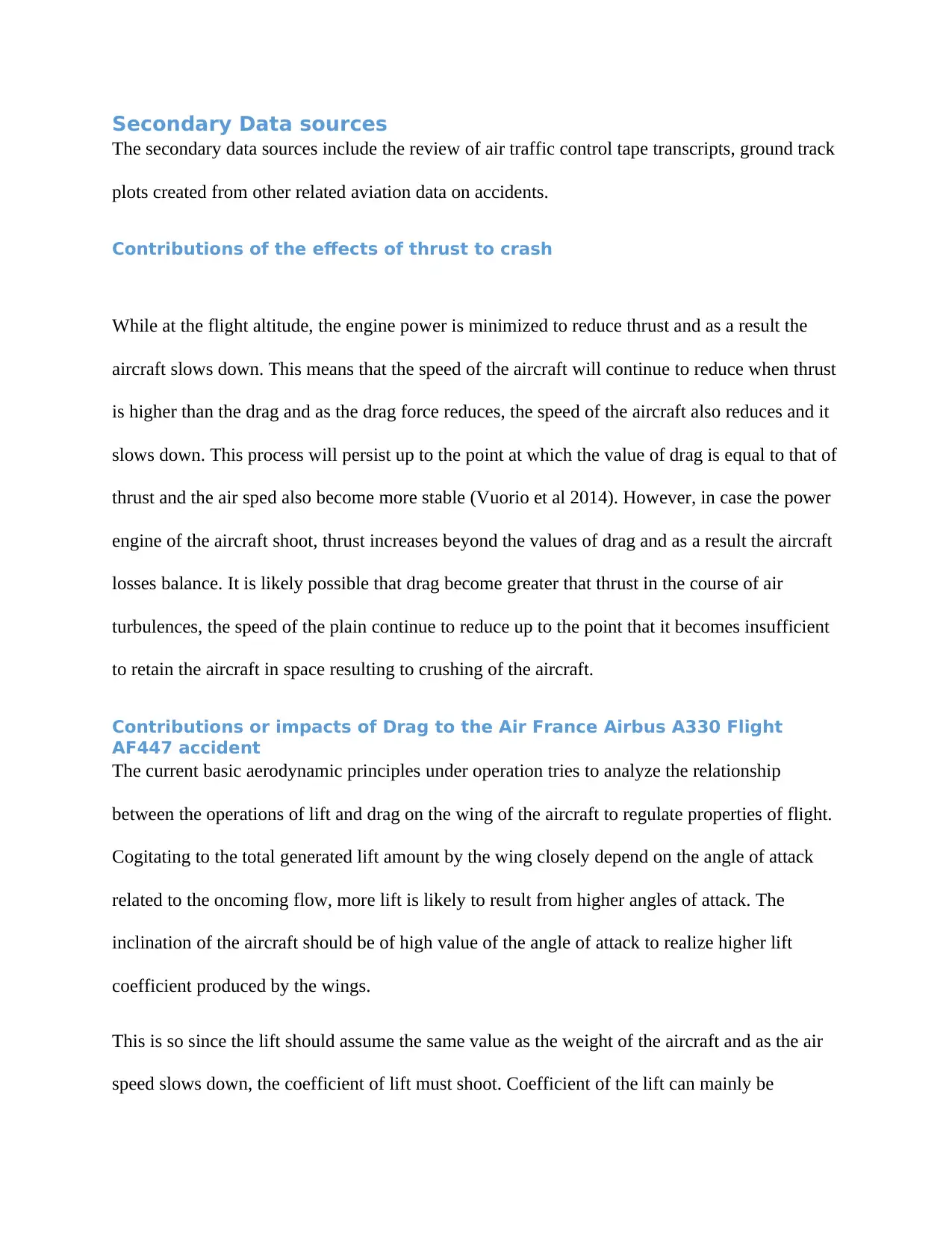
Secondary Data sources
The secondary data sources include the review of air traffic control tape transcripts, ground track
plots created from other related aviation data on accidents.
Contributions of the effects of thrust to crash
While at the flight altitude, the engine power is minimized to reduce thrust and as a result the
aircraft slows down. This means that the speed of the aircraft will continue to reduce when thrust
is higher than the drag and as the drag force reduces, the speed of the aircraft also reduces and it
slows down. This process will persist up to the point at which the value of drag is equal to that of
thrust and the air sped also become more stable (Vuorio et al 2014). However, in case the power
engine of the aircraft shoot, thrust increases beyond the values of drag and as a result the aircraft
losses balance. It is likely possible that drag become greater that thrust in the course of air
turbulences, the speed of the plain continue to reduce up to the point that it becomes insufficient
to retain the aircraft in space resulting to crushing of the aircraft.
Contributions or impacts of Drag to the Air France Airbus A330 Flight
AF447 accident
The current basic aerodynamic principles under operation tries to analyze the relationship
between the operations of lift and drag on the wing of the aircraft to regulate properties of flight.
Cogitating to the total generated lift amount by the wing closely depend on the angle of attack
related to the oncoming flow, more lift is likely to result from higher angles of attack. The
inclination of the aircraft should be of high value of the angle of attack to realize higher lift
coefficient produced by the wings.
This is so since the lift should assume the same value as the weight of the aircraft and as the air
speed slows down, the coefficient of lift must shoot. Coefficient of the lift can mainly be
The secondary data sources include the review of air traffic control tape transcripts, ground track
plots created from other related aviation data on accidents.
Contributions of the effects of thrust to crash
While at the flight altitude, the engine power is minimized to reduce thrust and as a result the
aircraft slows down. This means that the speed of the aircraft will continue to reduce when thrust
is higher than the drag and as the drag force reduces, the speed of the aircraft also reduces and it
slows down. This process will persist up to the point at which the value of drag is equal to that of
thrust and the air sped also become more stable (Vuorio et al 2014). However, in case the power
engine of the aircraft shoot, thrust increases beyond the values of drag and as a result the aircraft
losses balance. It is likely possible that drag become greater that thrust in the course of air
turbulences, the speed of the plain continue to reduce up to the point that it becomes insufficient
to retain the aircraft in space resulting to crushing of the aircraft.
Contributions or impacts of Drag to the Air France Airbus A330 Flight
AF447 accident
The current basic aerodynamic principles under operation tries to analyze the relationship
between the operations of lift and drag on the wing of the aircraft to regulate properties of flight.
Cogitating to the total generated lift amount by the wing closely depend on the angle of attack
related to the oncoming flow, more lift is likely to result from higher angles of attack. The
inclination of the aircraft should be of high value of the angle of attack to realize higher lift
coefficient produced by the wings.
This is so since the lift should assume the same value as the weight of the aircraft and as the air
speed slows down, the coefficient of lift must shoot. Coefficient of the lift can mainly be
⊘ This is a preview!⊘
Do you want full access?
Subscribe today to unlock all pages.

Trusted by 1+ million students worldwide
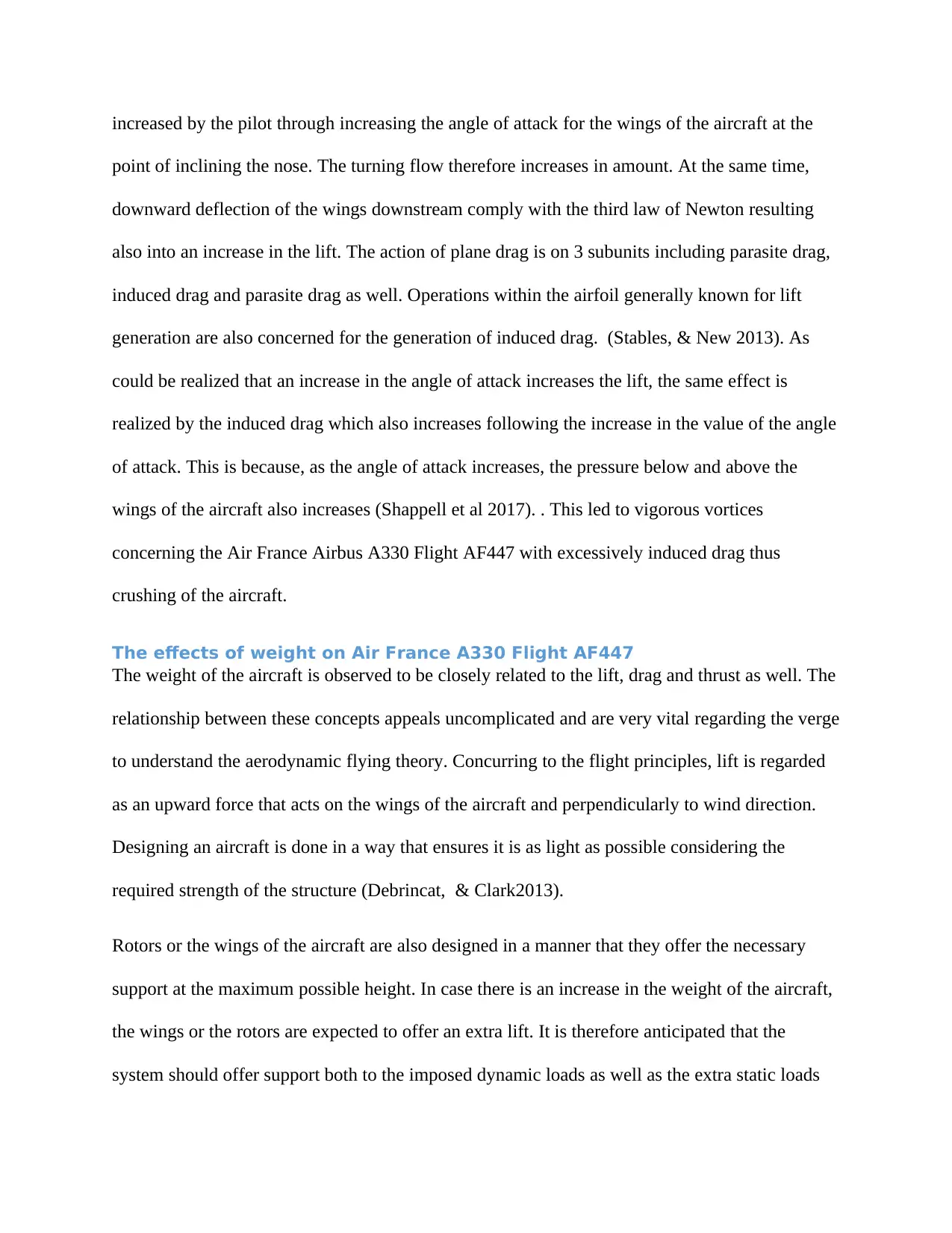
increased by the pilot through increasing the angle of attack for the wings of the aircraft at the
point of inclining the nose. The turning flow therefore increases in amount. At the same time,
downward deflection of the wings downstream comply with the third law of Newton resulting
also into an increase in the lift. The action of plane drag is on 3 subunits including parasite drag,
induced drag and parasite drag as well. Operations within the airfoil generally known for lift
generation are also concerned for the generation of induced drag. (Stables, & New 2013). As
could be realized that an increase in the angle of attack increases the lift, the same effect is
realized by the induced drag which also increases following the increase in the value of the angle
of attack. This is because, as the angle of attack increases, the pressure below and above the
wings of the aircraft also increases (Shappell et al 2017). . This led to vigorous vortices
concerning the Air France Airbus A330 Flight AF447 with excessively induced drag thus
crushing of the aircraft.
The effects of weight on Air France A330 Flight AF447
The weight of the aircraft is observed to be closely related to the lift, drag and thrust as well. The
relationship between these concepts appeals uncomplicated and are very vital regarding the verge
to understand the aerodynamic flying theory. Concurring to the flight principles, lift is regarded
as an upward force that acts on the wings of the aircraft and perpendicularly to wind direction.
Designing an aircraft is done in a way that ensures it is as light as possible considering the
required strength of the structure (Debrincat, & Clark2013).
Rotors or the wings of the aircraft are also designed in a manner that they offer the necessary
support at the maximum possible height. In case there is an increase in the weight of the aircraft,
the wings or the rotors are expected to offer an extra lift. It is therefore anticipated that the
system should offer support both to the imposed dynamic loads as well as the extra static loads
point of inclining the nose. The turning flow therefore increases in amount. At the same time,
downward deflection of the wings downstream comply with the third law of Newton resulting
also into an increase in the lift. The action of plane drag is on 3 subunits including parasite drag,
induced drag and parasite drag as well. Operations within the airfoil generally known for lift
generation are also concerned for the generation of induced drag. (Stables, & New 2013). As
could be realized that an increase in the angle of attack increases the lift, the same effect is
realized by the induced drag which also increases following the increase in the value of the angle
of attack. This is because, as the angle of attack increases, the pressure below and above the
wings of the aircraft also increases (Shappell et al 2017). . This led to vigorous vortices
concerning the Air France Airbus A330 Flight AF447 with excessively induced drag thus
crushing of the aircraft.
The effects of weight on Air France A330 Flight AF447
The weight of the aircraft is observed to be closely related to the lift, drag and thrust as well. The
relationship between these concepts appeals uncomplicated and are very vital regarding the verge
to understand the aerodynamic flying theory. Concurring to the flight principles, lift is regarded
as an upward force that acts on the wings of the aircraft and perpendicularly to wind direction.
Designing an aircraft is done in a way that ensures it is as light as possible considering the
required strength of the structure (Debrincat, & Clark2013).
Rotors or the wings of the aircraft are also designed in a manner that they offer the necessary
support at the maximum possible height. In case there is an increase in the weight of the aircraft,
the wings or the rotors are expected to offer an extra lift. It is therefore anticipated that the
system should offer support both to the imposed dynamic loads as well as the extra static loads
Paraphrase This Document
Need a fresh take? Get an instant paraphrase of this document with our AI Paraphraser
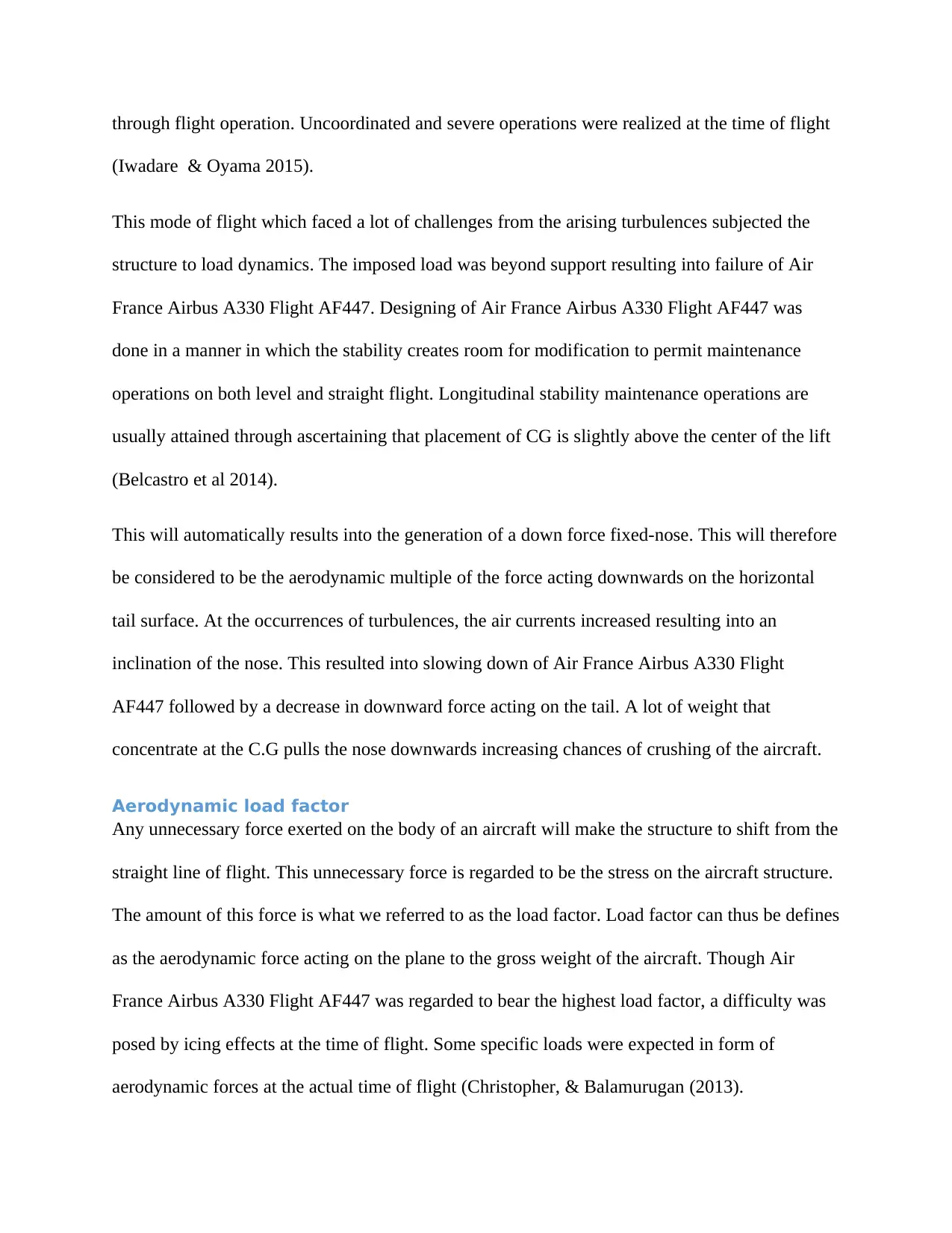
through flight operation. Uncoordinated and severe operations were realized at the time of flight
(Iwadare & Oyama 2015).
This mode of flight which faced a lot of challenges from the arising turbulences subjected the
structure to load dynamics. The imposed load was beyond support resulting into failure of Air
France Airbus A330 Flight AF447. Designing of Air France Airbus A330 Flight AF447 was
done in a manner in which the stability creates room for modification to permit maintenance
operations on both level and straight flight. Longitudinal stability maintenance operations are
usually attained through ascertaining that placement of CG is slightly above the center of the lift
(Belcastro et al 2014).
This will automatically results into the generation of a down force fixed-nose. This will therefore
be considered to be the aerodynamic multiple of the force acting downwards on the horizontal
tail surface. At the occurrences of turbulences, the air currents increased resulting into an
inclination of the nose. This resulted into slowing down of Air France Airbus A330 Flight
AF447 followed by a decrease in downward force acting on the tail. A lot of weight that
concentrate at the C.G pulls the nose downwards increasing chances of crushing of the aircraft.
Aerodynamic load factor
Any unnecessary force exerted on the body of an aircraft will make the structure to shift from the
straight line of flight. This unnecessary force is regarded to be the stress on the aircraft structure.
The amount of this force is what we referred to as the load factor. Load factor can thus be defines
as the aerodynamic force acting on the plane to the gross weight of the aircraft. Though Air
France Airbus A330 Flight AF447 was regarded to bear the highest load factor, a difficulty was
posed by icing effects at the time of flight. Some specific loads were expected in form of
aerodynamic forces at the actual time of flight (Christopher, & Balamurugan (2013).
(Iwadare & Oyama 2015).
This mode of flight which faced a lot of challenges from the arising turbulences subjected the
structure to load dynamics. The imposed load was beyond support resulting into failure of Air
France Airbus A330 Flight AF447. Designing of Air France Airbus A330 Flight AF447 was
done in a manner in which the stability creates room for modification to permit maintenance
operations on both level and straight flight. Longitudinal stability maintenance operations are
usually attained through ascertaining that placement of CG is slightly above the center of the lift
(Belcastro et al 2014).
This will automatically results into the generation of a down force fixed-nose. This will therefore
be considered to be the aerodynamic multiple of the force acting downwards on the horizontal
tail surface. At the occurrences of turbulences, the air currents increased resulting into an
inclination of the nose. This resulted into slowing down of Air France Airbus A330 Flight
AF447 followed by a decrease in downward force acting on the tail. A lot of weight that
concentrate at the C.G pulls the nose downwards increasing chances of crushing of the aircraft.
Aerodynamic load factor
Any unnecessary force exerted on the body of an aircraft will make the structure to shift from the
straight line of flight. This unnecessary force is regarded to be the stress on the aircraft structure.
The amount of this force is what we referred to as the load factor. Load factor can thus be defines
as the aerodynamic force acting on the plane to the gross weight of the aircraft. Though Air
France Airbus A330 Flight AF447 was regarded to bear the highest load factor, a difficulty was
posed by icing effects at the time of flight. Some specific loads were expected in form of
aerodynamic forces at the actual time of flight (Christopher, & Balamurugan (2013).
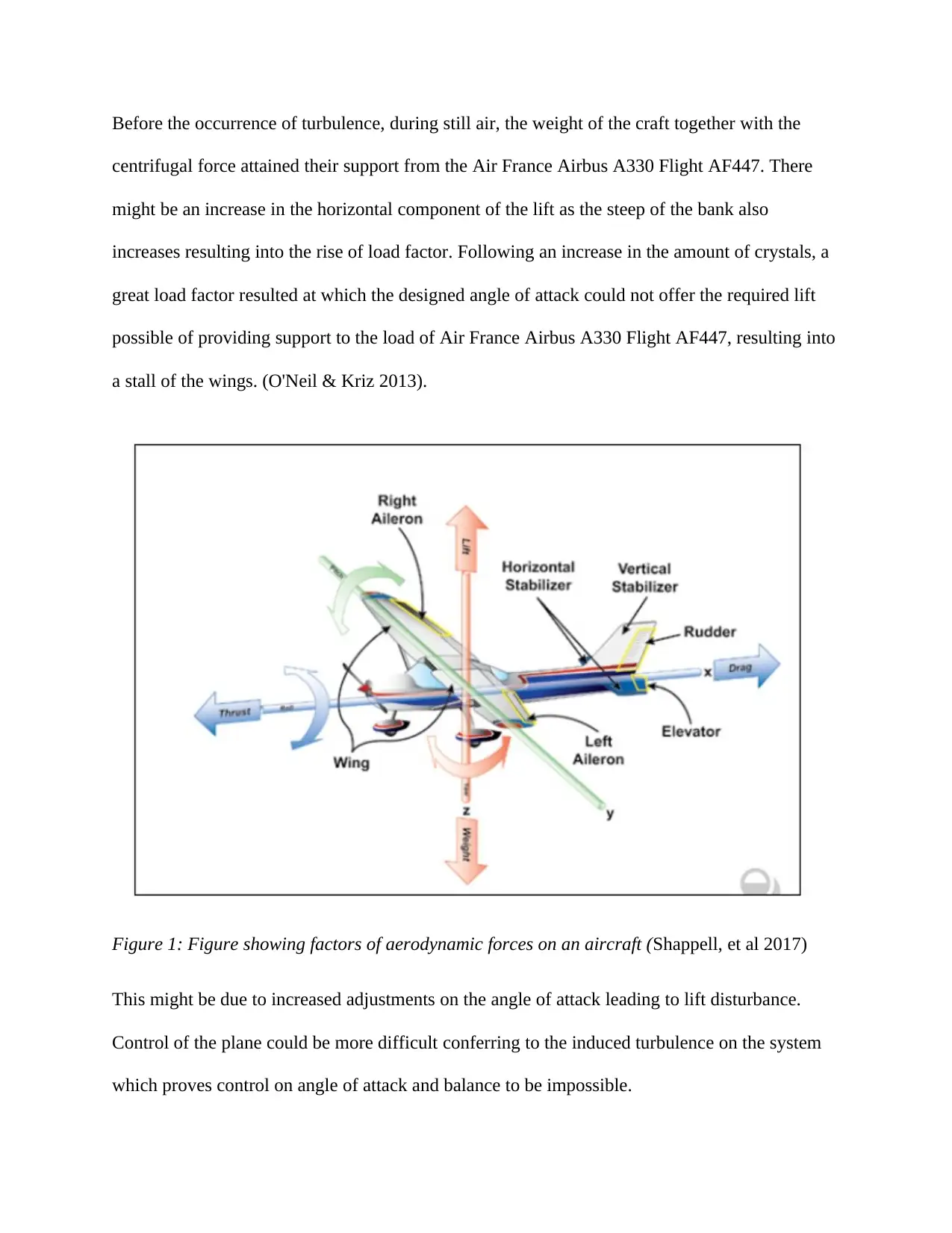
Before the occurrence of turbulence, during still air, the weight of the craft together with the
centrifugal force attained their support from the Air France Airbus A330 Flight AF447. There
might be an increase in the horizontal component of the lift as the steep of the bank also
increases resulting into the rise of load factor. Following an increase in the amount of crystals, a
great load factor resulted at which the designed angle of attack could not offer the required lift
possible of providing support to the load of Air France Airbus A330 Flight AF447, resulting into
a stall of the wings. (O'Neil & Kriz 2013).
Figure 1: Figure showing factors of aerodynamic forces on an aircraft (Shappell, et al 2017)
This might be due to increased adjustments on the angle of attack leading to lift disturbance.
Control of the plane could be more difficult conferring to the induced turbulence on the system
which proves control on angle of attack and balance to be impossible.
centrifugal force attained their support from the Air France Airbus A330 Flight AF447. There
might be an increase in the horizontal component of the lift as the steep of the bank also
increases resulting into the rise of load factor. Following an increase in the amount of crystals, a
great load factor resulted at which the designed angle of attack could not offer the required lift
possible of providing support to the load of Air France Airbus A330 Flight AF447, resulting into
a stall of the wings. (O'Neil & Kriz 2013).
Figure 1: Figure showing factors of aerodynamic forces on an aircraft (Shappell, et al 2017)
This might be due to increased adjustments on the angle of attack leading to lift disturbance.
Control of the plane could be more difficult conferring to the induced turbulence on the system
which proves control on angle of attack and balance to be impossible.
⊘ This is a preview!⊘
Do you want full access?
Subscribe today to unlock all pages.

Trusted by 1+ million students worldwide
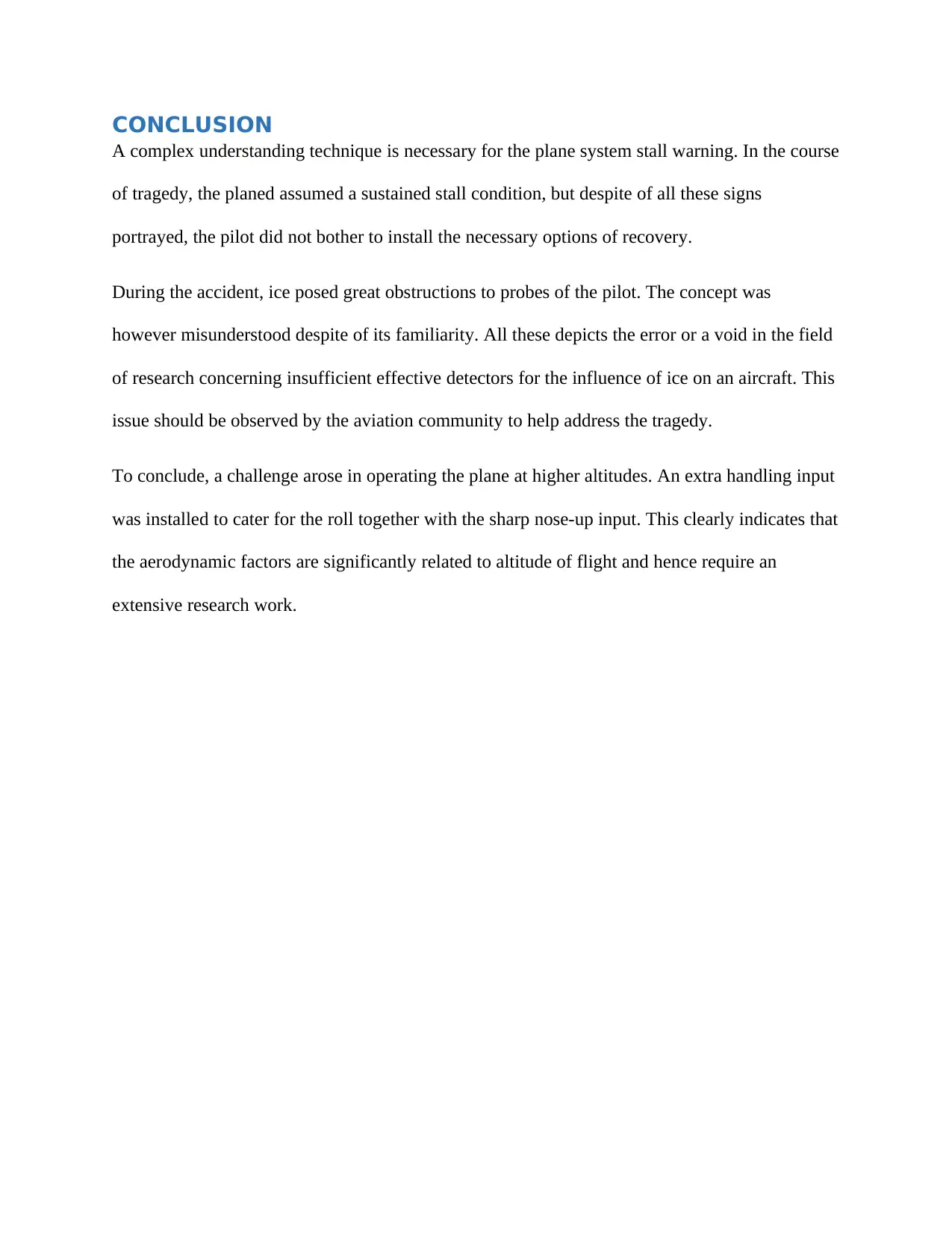
CONCLUSION
A complex understanding technique is necessary for the plane system stall warning. In the course
of tragedy, the planed assumed a sustained stall condition, but despite of all these signs
portrayed, the pilot did not bother to install the necessary options of recovery.
During the accident, ice posed great obstructions to probes of the pilot. The concept was
however misunderstood despite of its familiarity. All these depicts the error or a void in the field
of research concerning insufficient effective detectors for the influence of ice on an aircraft. This
issue should be observed by the aviation community to help address the tragedy.
To conclude, a challenge arose in operating the plane at higher altitudes. An extra handling input
was installed to cater for the roll together with the sharp nose-up input. This clearly indicates that
the aerodynamic factors are significantly related to altitude of flight and hence require an
extensive research work.
A complex understanding technique is necessary for the plane system stall warning. In the course
of tragedy, the planed assumed a sustained stall condition, but despite of all these signs
portrayed, the pilot did not bother to install the necessary options of recovery.
During the accident, ice posed great obstructions to probes of the pilot. The concept was
however misunderstood despite of its familiarity. All these depicts the error or a void in the field
of research concerning insufficient effective detectors for the influence of ice on an aircraft. This
issue should be observed by the aviation community to help address the tragedy.
To conclude, a challenge arose in operating the plane at higher altitudes. An extra handling input
was installed to cater for the roll together with the sharp nose-up input. This clearly indicates that
the aerodynamic factors are significantly related to altitude of flight and hence require an
extensive research work.
Paraphrase This Document
Need a fresh take? Get an instant paraphrase of this document with our AI Paraphraser
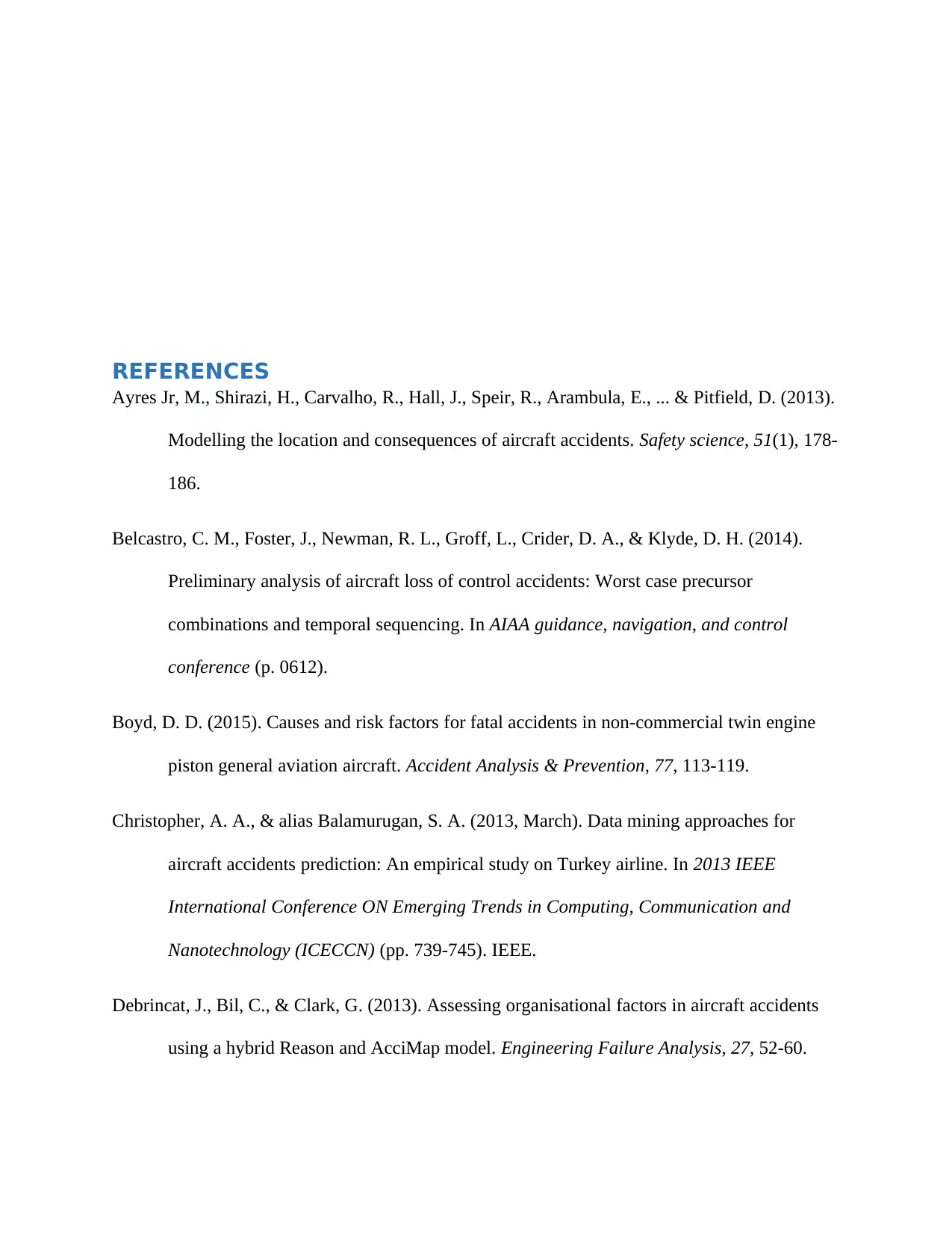
REFERENCES
Ayres Jr, M., Shirazi, H., Carvalho, R., Hall, J., Speir, R., Arambula, E., ... & Pitfield, D. (2013).
Modelling the location and consequences of aircraft accidents. Safety science, 51(1), 178-
186.
Belcastro, C. M., Foster, J., Newman, R. L., Groff, L., Crider, D. A., & Klyde, D. H. (2014).
Preliminary analysis of aircraft loss of control accidents: Worst case precursor
combinations and temporal sequencing. In AIAA guidance, navigation, and control
conference (p. 0612).
Boyd, D. D. (2015). Causes and risk factors for fatal accidents in non-commercial twin engine
piston general aviation aircraft. Accident Analysis & Prevention, 77, 113-119.
Christopher, A. A., & alias Balamurugan, S. A. (2013, March). Data mining approaches for
aircraft accidents prediction: An empirical study on Turkey airline. In 2013 IEEE
International Conference ON Emerging Trends in Computing, Communication and
Nanotechnology (ICECCN) (pp. 739-745). IEEE.
Debrincat, J., Bil, C., & Clark, G. (2013). Assessing organisational factors in aircraft accidents
using a hybrid Reason and AcciMap model. Engineering Failure Analysis, 27, 52-60.
Ayres Jr, M., Shirazi, H., Carvalho, R., Hall, J., Speir, R., Arambula, E., ... & Pitfield, D. (2013).
Modelling the location and consequences of aircraft accidents. Safety science, 51(1), 178-
186.
Belcastro, C. M., Foster, J., Newman, R. L., Groff, L., Crider, D. A., & Klyde, D. H. (2014).
Preliminary analysis of aircraft loss of control accidents: Worst case precursor
combinations and temporal sequencing. In AIAA guidance, navigation, and control
conference (p. 0612).
Boyd, D. D. (2015). Causes and risk factors for fatal accidents in non-commercial twin engine
piston general aviation aircraft. Accident Analysis & Prevention, 77, 113-119.
Christopher, A. A., & alias Balamurugan, S. A. (2013, March). Data mining approaches for
aircraft accidents prediction: An empirical study on Turkey airline. In 2013 IEEE
International Conference ON Emerging Trends in Computing, Communication and
Nanotechnology (ICECCN) (pp. 739-745). IEEE.
Debrincat, J., Bil, C., & Clark, G. (2013). Assessing organisational factors in aircraft accidents
using a hybrid Reason and AcciMap model. Engineering Failure Analysis, 27, 52-60.
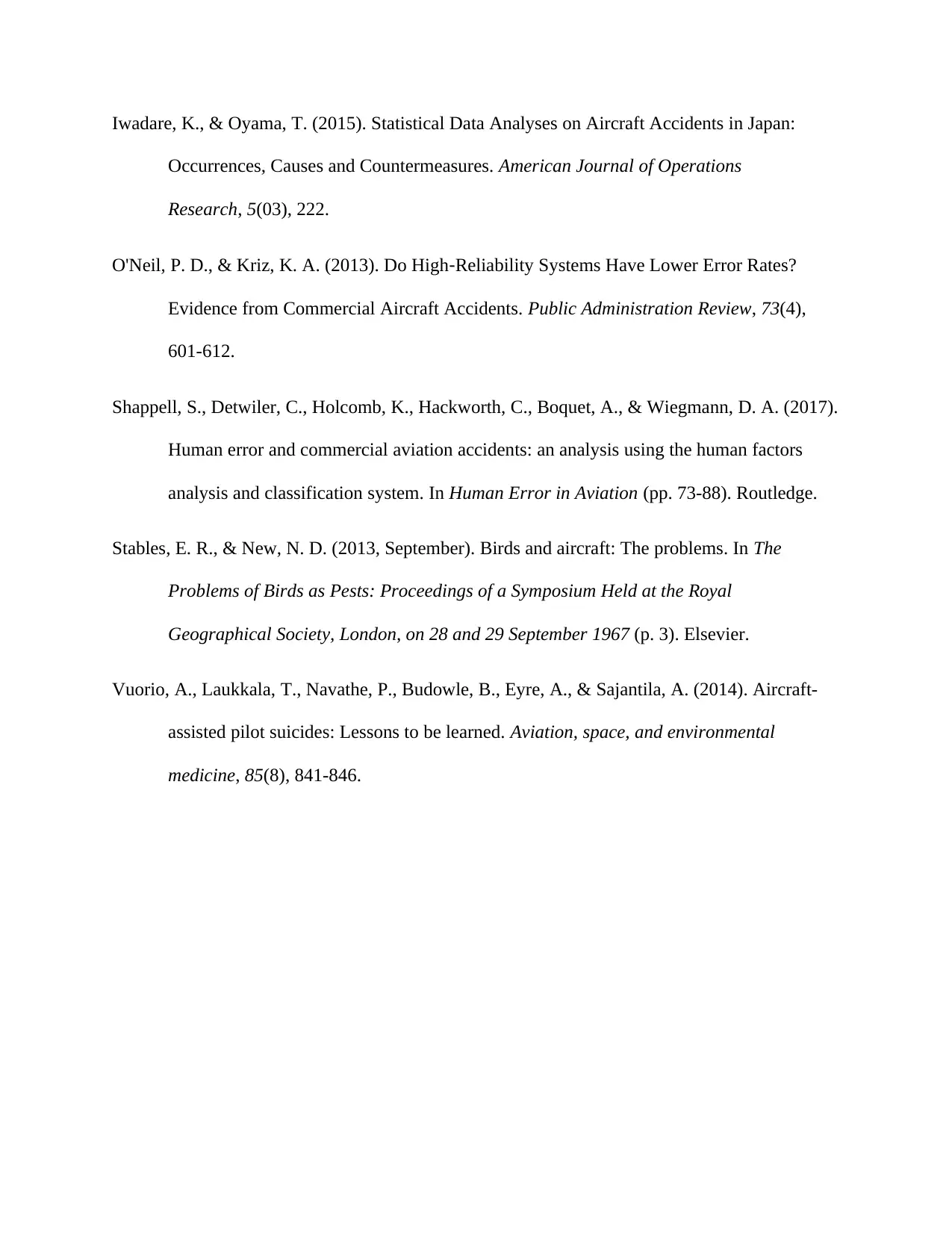
Iwadare, K., & Oyama, T. (2015). Statistical Data Analyses on Aircraft Accidents in Japan:
Occurrences, Causes and Countermeasures. American Journal of Operations
Research, 5(03), 222.
O'Neil, P. D., & Kriz, K. A. (2013). Do High‐Reliability Systems Have Lower Error Rates?
Evidence from Commercial Aircraft Accidents. Public Administration Review, 73(4),
601-612.
Shappell, S., Detwiler, C., Holcomb, K., Hackworth, C., Boquet, A., & Wiegmann, D. A. (2017).
Human error and commercial aviation accidents: an analysis using the human factors
analysis and classification system. In Human Error in Aviation (pp. 73-88). Routledge.
Stables, E. R., & New, N. D. (2013, September). Birds and aircraft: The problems. In The
Problems of Birds as Pests: Proceedings of a Symposium Held at the Royal
Geographical Society, London, on 28 and 29 September 1967 (p. 3). Elsevier.
Vuorio, A., Laukkala, T., Navathe, P., Budowle, B., Eyre, A., & Sajantila, A. (2014). Aircraft-
assisted pilot suicides: Lessons to be learned. Aviation, space, and environmental
medicine, 85(8), 841-846.
Occurrences, Causes and Countermeasures. American Journal of Operations
Research, 5(03), 222.
O'Neil, P. D., & Kriz, K. A. (2013). Do High‐Reliability Systems Have Lower Error Rates?
Evidence from Commercial Aircraft Accidents. Public Administration Review, 73(4),
601-612.
Shappell, S., Detwiler, C., Holcomb, K., Hackworth, C., Boquet, A., & Wiegmann, D. A. (2017).
Human error and commercial aviation accidents: an analysis using the human factors
analysis and classification system. In Human Error in Aviation (pp. 73-88). Routledge.
Stables, E. R., & New, N. D. (2013, September). Birds and aircraft: The problems. In The
Problems of Birds as Pests: Proceedings of a Symposium Held at the Royal
Geographical Society, London, on 28 and 29 September 1967 (p. 3). Elsevier.
Vuorio, A., Laukkala, T., Navathe, P., Budowle, B., Eyre, A., & Sajantila, A. (2014). Aircraft-
assisted pilot suicides: Lessons to be learned. Aviation, space, and environmental
medicine, 85(8), 841-846.
⊘ This is a preview!⊘
Do you want full access?
Subscribe today to unlock all pages.

Trusted by 1+ million students worldwide
1 out of 13
Your All-in-One AI-Powered Toolkit for Academic Success.
+13062052269
info@desklib.com
Available 24*7 on WhatsApp / Email
![[object Object]](/_next/static/media/star-bottom.7253800d.svg)
Unlock your academic potential
Copyright © 2020–2025 A2Z Services. All Rights Reserved. Developed and managed by ZUCOL.